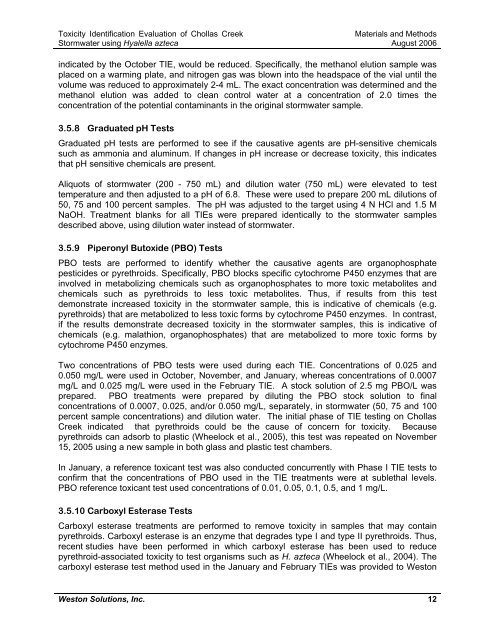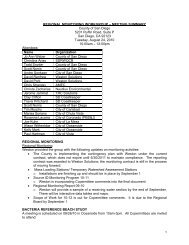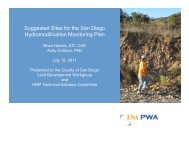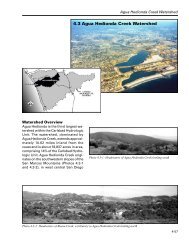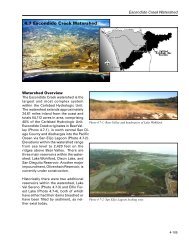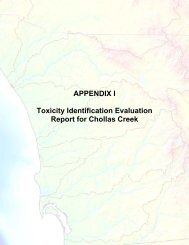APPENDIX I Toxicity Identification Evaluation Reports for Chollas ...
APPENDIX I Toxicity Identification Evaluation Reports for Chollas ...
APPENDIX I Toxicity Identification Evaluation Reports for Chollas ...
Create successful ePaper yourself
Turn your PDF publications into a flip-book with our unique Google optimized e-Paper software.
<strong>Toxicity</strong> <strong>Identification</strong> <strong>Evaluation</strong> of <strong>Chollas</strong> Creek<br />
Stormwater using Hyalella azteca<br />
Materials and Methods<br />
August 2006<br />
indicated by the October TIE, would be reduced. Specifically, the methanol elution sample was<br />
placed on a warming plate, and nitrogen gas was blown into the headspace of the vial until the<br />
volume was reduced to approximately 2-4 mL. The exact concentration was determined and the<br />
methanol elution was added to clean control water at a concentration of 2.0 times the<br />
concentration of the potential contaminants in the original stormwater sample.<br />
3.5.8 Graduated pH Tests<br />
Graduated pH tests are per<strong>for</strong>med to see if the causative agents are pH-sensitive chemicals<br />
such as ammonia and aluminum. If changes in pH increase or decrease toxicity, this indicates<br />
that pH sensitive chemicals are present.<br />
Aliquots of stormwater (200 - 750 mL) and dilution water (750 mL) were elevated to test<br />
temperature and then adjusted to a pH of 6.8. These were used to prepare 200 mL dilutions of<br />
50, 75 and 100 percent samples. The pH was adjusted to the target using 4 N HCl and 1.5 M<br />
NaOH. Treatment blanks <strong>for</strong> all TIEs were prepared identically to the stormwater samples<br />
described above, using dilution water instead of stormwater.<br />
3.5.9 Piperonyl Butoxide (PBO) Tests<br />
PBO tests are per<strong>for</strong>med to identify whether the causative agents are organophosphate<br />
pesticides or pyrethroids. Specifically, PBO blocks specific cytochrome P450 enzymes that are<br />
involved in metabolizing chemicals such as organophosphates to more toxic metabolites and<br />
chemicals such as pyrethroids to less toxic metabolites. Thus, if results from this test<br />
demonstrate increased toxicity in the stormwater sample, this is indicative of chemicals (e.g.<br />
pyrethroids) that are metabolized to less toxic <strong>for</strong>ms by cytochrome P450 enzymes. In contrast,<br />
if the results demonstrate decreased toxicity in the stormwater samples, this is indicative of<br />
chemicals (e.g. malathion, organophosphates) that are metabolized to more toxic <strong>for</strong>ms by<br />
cytochrome P450 enzymes.<br />
Two concentrations of PBO tests were used during each TIE. Concentrations of 0.025 and<br />
0.050 mg/L were used in October, November, and January, whereas concentrations of 0.0007<br />
mg/L and 0.025 mg/L were used in the February TIE. A stock solution of 2.5 mg PBO/L was<br />
prepared. PBO treatments were prepared by diluting the PBO stock solution to final<br />
concentrations of 0.0007, 0.025, and/or 0.050 mg/L, separately, in stormwater (50, 75 and 100<br />
percent sample concentrations) and dilution water. The initial phase of TIE testing on <strong>Chollas</strong><br />
Creek indicated that pyrethroids could be the cause of concern <strong>for</strong> toxicity. Because<br />
pyrethroids can adsorb to plastic (Wheelock et al., 2005), this test was repeated on November<br />
15, 2005 using a new sample in both glass and plastic test chambers.<br />
In January, a reference toxicant test was also conducted concurrently with Phase I TIE tests to<br />
confirm that the concentrations of PBO used in the TIE treatments were at sublethal levels.<br />
PBO reference toxicant test used concentrations of 0.01, 0.05, 0.1, 0.5, and 1 mg/L.<br />
3.5.10 Carboxyl Esterase Tests<br />
Carboxyl esterase treatments are per<strong>for</strong>med to remove toxicity in samples that may contain<br />
pyrethroids. Carboxyl esterase is an enzyme that degrades type I and type II pyrethroids. Thus,<br />
recent studies have been per<strong>for</strong>med in which carboxyl esterase has been used to reduce<br />
pyrethroid-associated toxicity to test organisms such as H. azteca (Wheelock et al., 2004). The<br />
carboxyl esterase test method used in the January and February TIEs was provided to Weston<br />
Weston Solutions, Inc. 12


